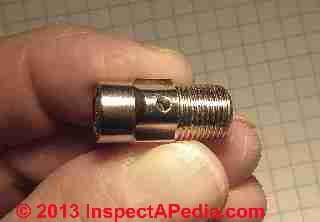 Radiator Plug Removal & Repair Procedure
Radiator Plug Removal & Repair Procedure
How to remove a cast radiator plug to install an air vent
- POST a QUESTION or COMMENT about troubleshooting problems bleeding the air out of hot water heating system radiators, baseboards, convectors etc.
Radiator repairs: how to get out the cast iron plug.
When a steam heating system was later converted to forced hot water heat someone would have removed the steam vent and plugged its mounting opening.
At that time the installer should have also installed an air bleed control valve near the radiator top. But some installers may have omitted the vent at one or more radiators. The result is a radiator that never gets warm or never gets warm enough.
Here we describe how to get out a stubborn, painted-over or rusted-in-place plug in a cast iron radiator. Speaking from experience we also describe what goes wrong and how to get out of that new level of trouble.
Page top photo: a painted-over square-sided pipe plug in a cast iron radiator. This is probably plugging a steam vent connection in a radiator converted to hydronic (hot water) heat.
InspectAPedia tolerates no conflicts of interest. We have no relationship with advertisers, products, or services discussed at this website.
- Daniel Friedman, Publisher/Editor/Author - See WHO ARE WE?
How to Remove & Replace a Painted-in Rusted-in Pipe Plug or Air Bleeder From a Radiator
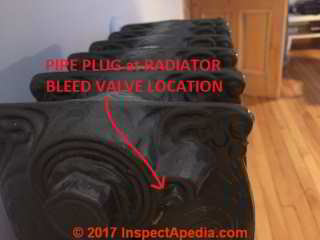 If you have already removed an old pipe plug or air bleeder vent from your radiator or if you don't anticipate any trouble getting the old one out, the procedure at AIR BLEED VALVE INSTALLATION will suffice.
If you have already removed an old pipe plug or air bleeder vent from your radiator or if you don't anticipate any trouble getting the old one out, the procedure at AIR BLEED VALVE INSTALLATION will suffice.
If you are faced with removing a painted over and rusted-in-place pipe plug or broken radiator vent some removal and repair suggestions are given here.
Question: how to replace a radiator pipe plug with an air bleeder valve
I would like to know how to remove the small cast square plug on my cast iron radiator and install a manual air bleeder valve.(See attached photos)
Once the plug removed - will I need to thread the hole for the bleeder ?
I came across this interesting article on a website - Removing Worn Bleed Screws - [given below - Ed.]
Based on that article - my square plug would be a bleed screw ?
Do you know where I can purchase a Bleed valve replacement kit with tap wrench on a canadian or USA website ?
If it is to hard to remove the bleed nut or screw - wouldn't it be easier to make a new hole on the opposite side and install the new bleeder ?
- Anonymous by private email 2017/12/14 [Click to enlarge any image]
Reply: try to remove the plug without breaking it off, then install an air bleeder valve
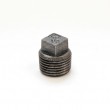 I nervous about this answer because we both know what can go wrong.
I nervous about this answer because we both know what can go wrong.
Your radiator sports what looks like a conventional pipe plug in the bleeder opening, not a radiator bleeder valve.
Regarding that square-headed plug / bleeder, I'd also not expect such a device to be made of other than brass as raw steel will corrode enough that the valve seat will have a short life.
The silver colored bleeder valves you see in some radiators or for sale are typically chrome plated brass or steel [shown below] .
Make this test: scrape away the paint from the square end of your plug and see if it is brass or iron.
OR you might just confirm that the plug is iron using a magnet.
We often find that cast iron radiators that were originally connected to a two-pipe steam heating system will have a plug in this location (near the top of the radiator).
That's because the steam vent on a radiator was often located lower on the radiator body.
Steps in Removing An Old Radiator Plug
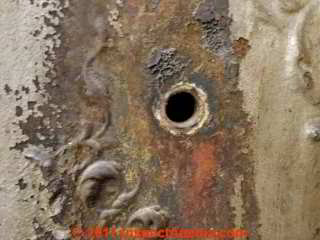 Our photo shows a typical tapping in a different cast iron steam radiator, after a steam vent or pipe plug has been removed. This American-Radiator Company antique radiator, located at 190 Bowery in New York City, was not in use. This offers evidence that it is possible to remove old rusted fittings from a tapped opening.
Our photo shows a typical tapping in a different cast iron steam radiator, after a steam vent or pipe plug has been removed. This American-Radiator Company antique radiator, located at 190 Bowery in New York City, was not in use. This offers evidence that it is possible to remove old rusted fittings from a tapped opening.
- Turn off the heat and let things cool down - safer would be to wait until we're not in the heating season to do any heavy torquing so that if you break off the plug leaving a leaky radiator you will have the summer to fix the radiator out of the heating season.
But you probably want to install an air bleeder rather than having to go through another winter of cold radiators.
Watch out: also relieve the boiler pressure: you may want to actually turn off the water feed to your boiler (the boiler is off, right?) and remove enough water to drop the pressure down close to zero - you do not have to actually drain the system.
Probably the radiator that's cold has air in its top anyhow so if you release the pressure in the system you may not have hot nasty water squirting into the room when you snap off the pipe pug (or get it out nicely). - Remove as much paint as you can from the plug and its point of entry into the radiator. Take your time to be very thorough. The more paint you can pick out of the intersection of the threaded plug and the radiator face the better your penetrating oil can work in the next step below.
Do that cleaning gently enough that you're not gouging or damaging the radiator. You can use a screwdriver, then an ice pick or dental tool and a small wire brush or even your husband's old toothbrush.
- Use penetrating lubricant: Soak the fitting where the pipe plug threads enter the radiator body for a few minutes with some Liquid Wrench® penetrant / lubricant (or equivalent) that might help loosen the fitting.
Any oil, including WD40 or other low viscosity lubricants can help in a pinch, but penetrating oils are more effective than ordinary oil at loosening rusted frozen metal parts. Give the Liquid Wrench time to work and soak it a couple of times.
Wipe off the oil that runs down the radiator before it gets on the floor.
Watch out: DO NOT try to also use a torch or flame to heat the rusted fitting. Liquid Wrench as well as other penetrating lubricants are highly flammable. You could have a bad experience. - Tap GENTLYOn the pipe plug side to loosen it and re-apply the penetrant again. Wait.
Watch out: DO NOT go banging on the radiator or the plug with great hammering force. Like Thor with his Mjǫllnir did to change his armor, just tap gently. Otherwise, when you crack the radiator you'll get that sick to the stomach sensation.
- Try turning out the pipe plug with a spanner (wrench for Trumplandiers) using moderate force. If the plug is too worn to grip with a spanner use a locking pliers such as Vise Grips™.
Once it begins to turn you can keep the plug turning more-easily with a drop more of your penetrating lubricant - the can you bought is probably a lifetime supply anyhow.Normally you'd put a wrench or if the plug is not square a vise-grip on the plug, turn it counter clockwise, remove it, clean the exposed threads, use pipe dope or teflon tape and screw in your air bleeder valve - assuming this is a forced hot water radiator (not steam heat).
Of course if the plug has been there for 90 years it may be rusted in place. It could break off when you're trying to remove it. Or you could remove it and the threads are in horrible shape (less likely) and could give you trouble screwing in the vent. There are drill-out and repair kits for this problem. We'll discuss those below.
Watch out: Quit trying if a moderate force didn't get the plug turning. There is some judgment in applying force stopping short of breaking the whole assembly apart.
When you break off the plug (let's try not to do that) and leave a leak in the radiator you might be able to make temporary salvage using repair epoxy but future plumbers will really be annoyed. Below I will describe a better repair using a heli-coil threaded repair fitting.
Keep Calm and Carry On.
- Clean & prepare the threaded tapping in the radiator - a toothbrush, a small wire brush can improve the result. If the opening is so rusted that you cannot reliably thread in a new air bleed valve you'll need to drill out the hole, tap in new threads and install a helicoil repair kit as we discuss below.
- Prepare the New Radiator Air Bleeder valve with teflon tape or a pipe thread sealant
- Screw in the Air Bleeder Valve - see AIR BLEED VALVE INSTALLATION for some examples, or if you need one, try AIR BLEED VALVE SOURCES.
- Restore the heating system's water supply, turn on heat, let pressure rise,
- Check for leaks at the repaired tapped and threaded air vent valve. If the fitting is leaking and the leak isn't stopped by gently tightening the fitting a but further you'll need to cool off the system, release pressure, and re-make your connection.
- Bleed air out of the cold radiator using the new air vent control. See AIR BLEEDER VALVES for an explanation of how these valves work and how to use them.
How to Repair a Broken-Off or Stripped-Thread Radiator Air Bleeder Opening & Valve
 Radiator air vents or air bleeders normally have at least two components: a tapered valve, typically brass, whose point seats into a mating, machined brass seat. Unscrewing the valve permits air to vent from the radiator.
Radiator air vents or air bleeders normally have at least two components: a tapered valve, typically brass, whose point seats into a mating, machined brass seat. Unscrewing the valve permits air to vent from the radiator.
The whole air bleeder assembly apparatus then being screwed into the vented radiator.
If the radiator's tapping intended to receive the air bent is badly damaged it can often be repaired by drilling, tapping, and inserting a wire thread insert.
Above: a typical chrome plated air bleed valve in a cast iron radiator - this one is in a home in Clinton Hill in Brooklyn NY. You'll notice that the mounting body of this vent is hexagonal rather than sporting the characteristic square shape of a cast iron or steel pipe plug.
Watch out: having broken off parts and hurt myself a time or two I've learned not to assume that everything will go according to plan when working on plumbing and heating systems. It's helpful to be prepared for trouble.
If the threads of the air bleeder tapping in the radiator are absolutely destroyed or if you break off the plug and have to drill it out, then you'll need to tap an oversized hole and either tap to the diameter and threads of a larger radiator vent or you'll use the tap-repair kit we mentioned previously and that I'll describe in more detail here.
A helical screw repair kit involves over-drilling the hole, tapping new threads into the hole (that's not as hard as it may seem), screwing in a threaded sleeve whose outer diameter matches the drilled, tapped hole, and whose inner diameter and threads match the vent to be screwed into the sleeve.
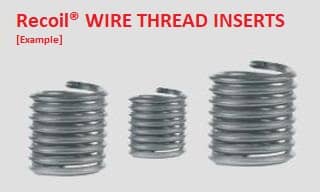 illustration: an example of a wire thread insert used to repair a drilled and tapped opening in a cast iron radiator (or other iron or metal parts). There are various forms of threaded inserts and similar terms may be used to find them including wire thread inserts, helicoil thread repair kits and thread repair kits.
illustration: an example of a wire thread insert used to repair a drilled and tapped opening in a cast iron radiator (or other iron or metal parts). There are various forms of threaded inserts and similar terms may be used to find them including wire thread inserts, helicoil thread repair kits and thread repair kits.
These parts are from Recoil - cited just below.
These helicoil repair kits used to be widely used in the automotive industry when we changed spark plugs so often that we over-tightened and stripped the spark plug hole in the engine.
["We" here means me and my '65 Mustang whose spark plugs lasted about 9000 Km between changes. ]
Obviously the inner threads of the sleeve have to match those of the plug or radiator vent to be inserted.
The outer threads match the diameter of the tread tapping tool that matches the drill size that's used to drill out the opening.
Thread Repair Kits & Penetration Oil for Repairing for Cast Iron Radiators
A typical thread repair kit will include the following:
- Drill bits in appropriate sizes
- Taps to cut threads into the drilled-out opening
- Possibly a thread cutting oil to assist the tapping.
- Inserts that thread into the tapped, drilled opening
- Tools to insert the insert
The choice of drill size and tap size and then insert size is made to suit the original threaded opening and original fitting. An over-size hole is drilled and an insert installed to reduce the new opening to the original or required threaded opening size and thread pitch to match the device (such as a radiator air bleed valve) that is to be installed.
The "sleeve" or insert in many thread repair kits is essentially a helical spring that is inserted and sealed into the receiving body.
- Bleed Screws, Radiator Parts, Wayford, Straight Road, Bradfield CO11 2RA England UK Phone: 07791 285951 E-mail: radiator.parts@yahoo.co.uk Website: https://www.bleedscrews.co.uk/removing-radiator-bleed-screws/
- Helical Wire, Inc. 26 Cash Drive • Carson City, NV 89706 USA Tel: 775.246.5333 Website: http://helicalwire.com/products/kits/
- Liquid Wrench, RSC Chemical Co., 600 Radiator Road Indian Trail, NC 28079 USA Tel: (866-973-6247) Website: https://www.liquidwrench.com - note that regular lubricating oil is not nearly so helpful in loosening rusted parts as is a penetrating oil like this one.
- Orbital Fasteners, Olds Approach, Tolpits Lane, Watford WD18 9XT 01923 777777 Website: https://www.orbitalfasteners.co.uk/en/categories/helical-thread-repair-inserts
- Recoil® Screw Thread Inserts, Arconic Fastening Systems and Rings, Tel: 0800-019-8180 Website: https://www.afsrrecoil.net/threadrepair/en/
Excerpt:
Recoil Thread Repair Kits contain a quality HSS tap, installation tool, precision stainless steel inserts (standard length is 1.5 x diameter) and instructions, in a sturdy reusable container. Recoil has a full range of problem solving repair kits, available in single or multiple size format. - Silverline 283928 Thread Repair Kit Helicoil Type M, 6 x 1.0 mm - Website: https://www.amazon.co.uk/Silverline-283928-Thread-Repair-Helicoil/dp/B001C7P9OW
InspectApedia.com has no business nor financial connection with any manufacturer or service provider discussed at our website. We do not sell products nor services.
What About Just Removing the Pipe Plug, Bleeding Air, Replacing the Plug?
It is also possible to bleed air from a radiator manually by simply removing a conventional pipe plug if that's what's screwed into the opening.
Watch out: The hazard of this approach is that as heat rises in the system you'll get dirty hot water spewing out of the open hole and you'll be frantically trying to start and then screw in the plug.
...
Reader Comments, Questions & Answers About The Article Above
Below you will find questions and answers previously posted on this page at its page bottom reader comment box.
Reader Q&A - also see RECOMMENDED ARTICLES & FAQs
Question: trouble getting the air out of an apparently air-bound heating system
We have a 2 zone hot water heating system that operates off of one thermostat. When calling for heat the 1st zone going to the 1st level of the home works good. The 2nd zone on the 2nd level has 6 baseboards and 3 seem to work good but 3 do not radiate heat at all. each one has a air bleeder on them and when I went to bleed the one off I got a little air but then got nothing, no water either. I it normal to have no pressure on them when not calling for heat or do I have an obstruction in the line such as frozen or some sort of dibree. - K.C. 1/27/14
Reply:
I suggested looking for clogged air bleeders (AIR BLEED VALVE LEAK REPAIR ) or for low system pressure. PRESSURE & TEMPERATURE SETTINGS, CONTROLS
Follow-up:
the heating system is at my moms and I went over there yesterday to take a look at it and couldn't find a pressure gauge or not much of a place to put one with out taking apart some thing.
When I got there I had noticed that the water supply valve was shut coming from the water well going to the make up point of the hot water system and wasn't sure if that was suppose to be left open so I opened it and it sounded like it was taking some. Let me know if that is suppose to be left open or not or will it hurt something if I do. When I did have it on and went to bleed the air I found quite a bit of air but when the air stopped I didn't get water and if I shut it and waited al little bit I could get some more air but no water.
Shouldn't there be enough pressure on the system to keep on forcing the air out until you get water so maybe the bladder is bad or I need to add some pressure to it somehow. I did find out that it is a loop system and there is a 1" pipe looping along side the out side of the house between the floor and ceiling of the upper and lower level and pipes Ting off of it to the baseboards.
That is why we are still getting good heat at 2 baseboards at the beginning of the run and 1 at the end of the run but 3 in the middle you will get the one end of the pipe might be warm to hot but at the other end might be luke warm to cold. could there be a blockage in those pipes caused by sediment from the water? Or maybe the pump that moves the hot water isn't working right. Let me know your thought. Thanks for your time and help. - K.C. 1/28/2014
Reply:
I cannot give safe advice about operating the controls on a heating system I can't see - there are just too many unknowns.
If the water to the boiler was shut off it may be that the system has ONLY a manual water feed. If this is hot water heat, (not steam heat) and if the boiler is not leaky, it may rarely ever need water added; if you pushed water in you may have overpressurized the boiler, which in turn can make the relief valves leak when the system heats up (another unsafe condition).
If on the other hand the boiler starting pressure was low, you might have addressed the original boiler pressure worry. But unless you bleed air until water comes out of the air bleeder valve, you have left air in the system - which can leave it air bound.
I think I would try forcing water into the system until I got water out at the air bleeder.
Then if I found I had too much pressure in the system, after bleeding out all the air one can always open a drain at the boiler to reduce the water pressure. (of course when you TOUCH an old part that nobody has touched for years it may break, leak or jam).
Watch out: for an old, not-working heating system that does not even seem to have normal safety controls and is in unknown condition, I don't think it's safe to keep fooling with it - you need to figure it's time to call a heating professional. We may try to offer some tips by email or online, but we are limited by your eyes - what you see and report. Often a pro will be able to home in on the no-heat problem almost immediately (that's a benefit of having a lot of experience).
Follow-up:
Thank you for your help. The resent info was some good advice. I did shut the water valve off today and it didn't seem to set off any reliefs but I did notice that there was a bleeder on top of the bladder assembly and the cap was on and when I took it off it seem to bleed alot of air out and then seem to bleed it out in spurts like it was an automatic air bleeder and when it did that I could hear water moving through the pipes better and went upstairs and was able to bleed air out of one of the baseboard until it came onto water which hadn't been able to do before and one of the shorter baseboards that she said hadn't been working in awhile was working now. sounds like slowly but surly things are starting to work. I know it is hard to give info when not here looking at it but thanks for the info you have given. At least it gave me some knowledge and will call some one in if can't get things working safely and normal.
Reply:
Sounds like progress. What's hard to determine from our conversation is to confirm that the system is air-bound (which I suspect) and whether you have found the bleed valves necessary to get that air out without having to call a heating service tech to force the air out of the system (using a pony pump at the boiler).
If you can keep bleeding air until water comes out at a bleeder that's what you want to do.
If you hear water moving through the pipes that was not moving before, you're making progress and we know the circulator must be working.
If you feel piping and it's hot for a ways from the boiler then is cold, that's probably where the air is blocking the system.
...
Continue reading at AIR BLEED VALVE INSTALLATION or select a topic from the closely-related articles below, or see the complete ARTICLE INDEX.
Or see these
Recommended Articles
- AIR BLEEDER VALVES - home
- AIR BLEED VALVE INSTALLATION
- AIR ELIMINATOR / FLOAT VENT REPLACEMENT
- AIR BLEED VALVE LEAK REPAIR
- AIR BLEED VALVE SOURCES
- AIR BLEEDER VALVE FUNCTIONS
- RADIATOR PLUG REMOVAL
Suggested citation for this web page
RADIATOR PLUG REMOVAL at InspectApedia.com - online encyclopedia of building & environmental inspection, testing, diagnosis, repair, & problem prevention advice.
Or see this
INDEX to RELATED ARTICLES: ARTICLE INDEX to HEATING RADIATORS
Or use the SEARCH BOX found below to Ask a Question or Search InspectApedia
Or see
INDEX to RELATED ARTICLES: ARTICLE INDEX to HEATING BOILERS
Or use the SEARCH BOX found below to Ask a Question or Search InspectApedia
Ask a Question or Search InspectApedia
Try the search box just below, or if you prefer, post a question or comment in the Comments box below and we will respond promptly.
Search the InspectApedia website
Note: appearance of your Comment below may be delayed: if your comment contains an image, photograph, web link, or text that looks to the software as if it might be a web link, your posting will appear after it has been approved by a moderator. Apologies for the delay.
Only one image can be added per comment but you can post as many comments, and therefore images, as you like.
You will not receive a notification when a response to your question has been posted.
Please bookmark this page to make it easy for you to check back for our response.
IF above you see "Comment Form is loading comments..." then COMMENT BOX - countable.ca / bawkbox.com IS NOT WORKING.
In any case you are welcome to send an email directly to us at InspectApedia.com at editor@inspectApedia.com
We'll reply to you directly. Please help us help you by noting, in your email, the URL of the InspectApedia page where you wanted to comment.
Citations & References
In addition to any citations in the article above, a full list is available on request.
- Domestic and Commercial Oil Burners, Charles H. Burkhardt, McGraw Hill Book Company, New York 3rd Ed 1969.
- National Fuel Gas Code (Z223.1) $16.00 and National Fuel Gas Code Handbook (Z223.2) $47.00 American Gas Association (A.G.A.), 1515 Wilson Boulevard, Arlington, VA 22209 also available from National Fire Protection Association, Batterymarch Park, Quincy, MA 02269. Fundamentals of Gas Appliance Venting and Ventilation, 1985, American Gas Association Laboratories, Engineering Services Department. American Gas Association, 1515 Wilson Boulevard, Arlington, VA 22209. Catalog #XHO585. Reprinted 1989.
- The Steam Book, 1984, Training and Education Department, Fluid Handling Division, ITT [probably out of print, possibly available from several home inspection supply companies] Fuel Oil and Oil Heat Magazine, October 1990, offers an update,
- Principles of Steam Heating, $13.25 includes postage. Fuel oil & Oil Heat Magazine, 389 Passaic Ave., Fairfield, NJ 07004.
- The Lost Art of Steam Heating, Dan Holohan, 516-579-3046 FAX
- Principles of Steam Heating, Dan Holohan, technical editor of Fuel Oil and Oil Heat magazine, 389 Passaic Ave., Fairfield, NJ 07004 ($12.+1.25 postage/handling).
- "Residential Steam Heating Systems", Instructional Technologies Institute, Inc., 145 "D" Grassy Plain St., Bethel, CT 06801 800/227-1663 [home inspection training material] 1987
- "Residential Hydronic (circulating hot water) Heating Systems", Instructional Technologies Institute, Inc., 145 "D" Grassy Plain St., Bethel, CT 06801 800/227-1663 [home inspection training material] 1987
- "Warm Air Heating Systems". Instructional Technologies Institute, Inc., 145 "D" Grassy Plain St., Bethel, CT 06801 800/227-1663 [home inspection training material] 1987
- Heating, Ventilating, and Air Conditioning Volume I, Heating Fundamentals,
- Boilers, Boiler Conversions, James E. Brumbaugh, ISBN 0-672-23389-4 (v. 1) Volume II, Oil, Gas, and Coal Burners, Controls, Ducts, Piping, Valves, James E. Brumbaugh, ISBN 0-672-23390-7 (v. 2) Volume III, Radiant Heating, Water Heaters, Ventilation, Air Conditioning, Heat Pumps, Air Cleaners, James E. Brumbaugh, ISBN 0-672-23383-5 (v. 3) or ISBN 0-672-23380-0 (set) Special Sales Director, Macmillan Publishing Co., 866 Third Ave., New York, NY 10022. Macmillan Publishing Co., NY
- Installation Guide for Residential Hydronic Heating Systems
- Installation Guide #200, The Hydronics Institute, 35 Russo Place, Berkeley Heights, NJ 07922
- The ABC's of Retention Head Oil Burners, National Association of Oil Heat Service Managers, TM 115, National Old Timers' Association of the Energy Industry, PO Box 168, Mineola, NY 11501. (Excellent tips on spotting problems on oil-fired heating equipment. Booklet.)
- Our recommended books about building & mechanical systems design, inspection, problem diagnosis, and repair, and about indoor environment and IAQ testing, diagnosis, and cleanup are at the InspectAPedia Bookstore. Also see our Book Reviews - InspectAPedia.
- The Steam Book, 1984, Training and Education Department, Fluid Handling Division, ITT [probably out of print, possibly available from several home inspection supply companies] Fuel Oil and Oil Heat Magazine, October 1990, offers an update,
- Principles of Steam Heating, $13.25 includes postage. Fuel oil & Oil Heat Magazine, 389 Passaic Ave., Fairfield, NJ 07004.
- The Lost Art of Steam Heating, Dan Holohan, 516-579-3046 FAX
- Principles of Steam Heating, Dan Holohan, technical editor of Fuel Oil and Oil Heat magazine, 389 Passaic Ave., Fairfield, NJ 07004 ($12.+1.25 postage/handling).
- "Residential Steam Heating Systems", Instructional Technologies Institute, Inc., 145 "D" Grassy Plain St., Bethel, CT 06801 800/227-1663 [home inspection training material] 1987
- "Residential Hydronic (circulating hot water) Heating Systems", Instructional Technologies Institute, Inc., 145 "D" Grassy Plain St., Bethel, CT 06801 800/227-1663 [home inspection training material] 1987
- Installation Guide for Residential Hydronic Heating Systems
- Installation Guide #200, The Hydronics Institute, 35 Russo Place, Berkeley Heights, NJ 07922
- In addition to citations & references found in this article, see the research citations given at the end of the related articles found at our suggested
CONTINUE READING or RECOMMENDED ARTICLES.
- Carson, Dunlop & Associates Ltd., 120 Carlton Street Suite 407, Toronto ON M5A 4K2. Tel: (416) 964-9415 1-800-268-7070 Email: info@carsondunlop.com. Alan Carson is a past president of ASHI, the American Society of Home Inspectors.
Thanks to Alan Carson and Bob Dunlop, for permission for InspectAPedia to use text excerpts from The HOME REFERENCE BOOK - the Encyclopedia of Homes and to use illustrations from The ILLUSTRATED HOME .
Carson Dunlop Associates provides extensive home inspection education and report writing material. In gratitude we provide links to tsome Carson Dunlop Associates products and services.


